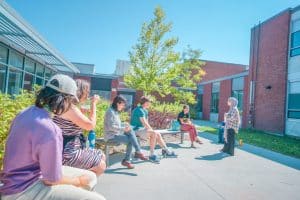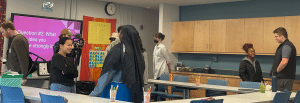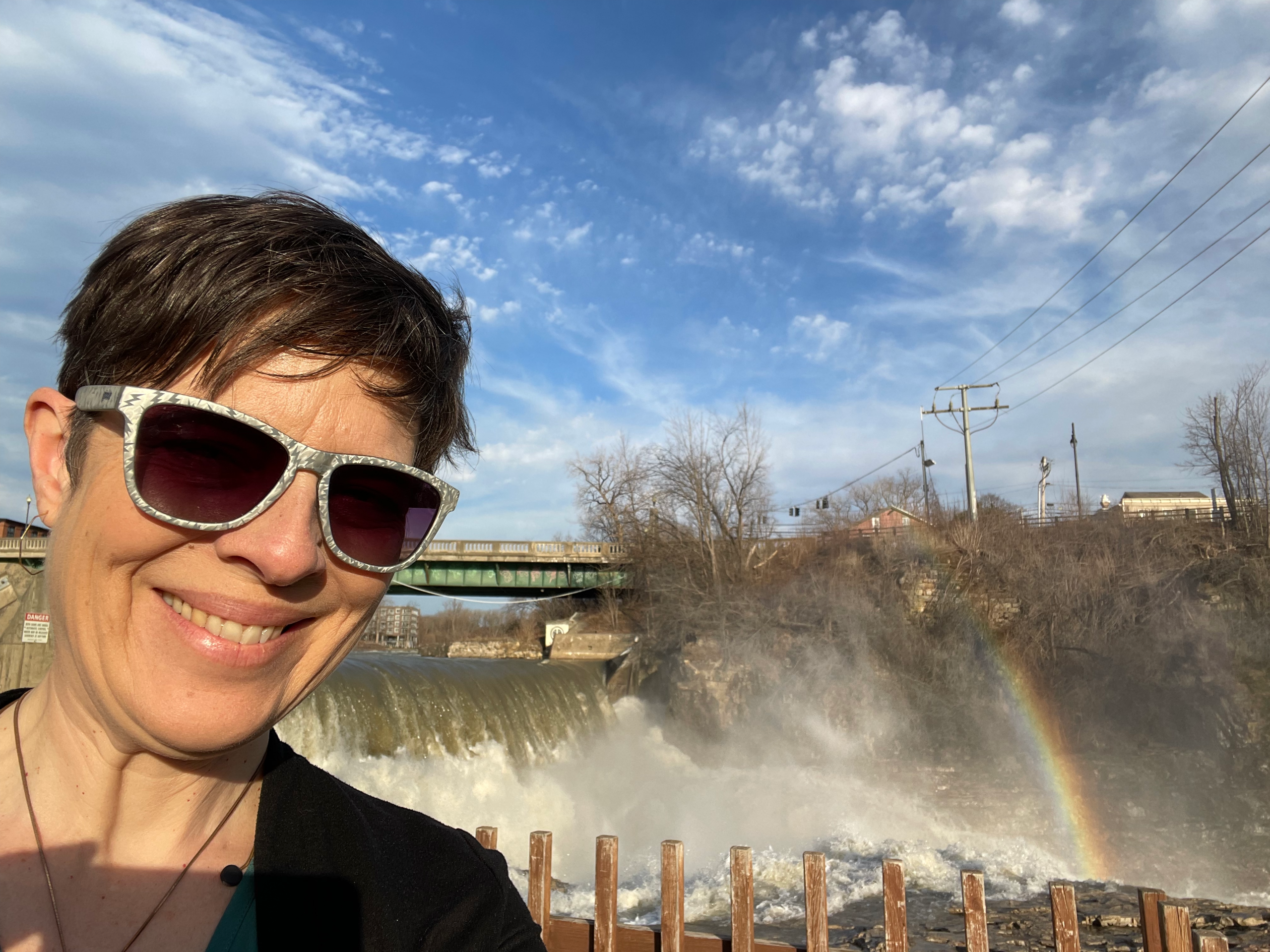Proficiency-Based Learning at Winooski
CompetencyWorks Blog
Throughout my time at Winooski Middle-High School (WMHS), I heard student stories of memorable learning experiences.
“My favorite capstone that I’ve done is my French capstone. I was actually able to teach a couple middle school classes in French and have them recorded. And I was able to show at my capstone the videos of me teaching French to younger students. My advisor on the project said, ‘the best way to show that you know something is to teach it to others.’ So that was a really strong piece of my capstone.” – Alexis
“For one of my year-end projects, for one of the capstone projects, I worked with the city to redo the tree ordinance, which is how the city manages the trees that we control. And right now, actually for the culture and community capstone, I’m working with the city again to set up an event between small businesses and youth in the city.” – Leo
“I did a sewing project. I did not know anything about sewing, but in that class, I had a teacher that taught me about sewing. I watched videos. Then when I went home, I started sewing, and that became a hobby to me.” – Noblette
The range of projects spanned traditional academics (the history of Mormonism, the role of feminism in World War II), to community-based (composting at the school), to a mix of it all (writing short stories based on the history of different types of cake and then baking the cakes!). The system to enable opportunities for student-directed learning has evolved for more than a decade, and continues to develop. There have been pivots and big lessons learned along the way, but Winooski’s approach to competency-based education (which they refer to as proficiency-based learning) is robust.

As we described in our opening post for this series, there are seven key elements that define competency-based education. These are:
- Essential competencies
- Equitable culture, structure, & pedagogy
- Student agency
- Meaningful assessment
- Responsive pacing
- Personalized pathways
- Timely differentiated support
This post explores the ways in which WMHS enacts these elements in their learning system.
Essential Competencies
Rigorous, common expectations for learning (knowledge, skills, and dispositions) are explicit, transparent, measurable, and transferable. (Aurora Institute)
Clear learning expectations that are known by adults and students alike form a framework within which learning experience can be designed flexibly to meet student needs and interests, as well as the demands of the world. The essential competencies at WMHS live in their graduation requirements. They include both “graduation proficiencies” and “graduate expectations”.
The graduation proficiencies focus on the disciplinary skills students need:
- Civic Reasoning
- Critical Reading
- Critical Writing
- Financial Literacy
- Historical Inquiry
- Mathematical Reasoning
- Non-Native Language
- Physical Health
- Scientific Reasoning
- Social-Emotional Health
- Speaking & Listening
- Performing or Visual Arts
The graduate expectations represent the cross-cutting skills students also need to be successful in using their disciplinary skills and knowledge:
- Communication
- Critical Thinking
- Culture and Community
- Persistence
- Creativity
- Wellbeing
Both the graduation proficiencies and graduate expectations include performance indicators that provide more detailed information about what students must demonstrate to meet the expectation for proficiency. Graduation proficiencies can be demonstrated through any learning experience – ranging from a course to a personalized, flexible pathway experience. Graduate expectations are demonstrated through a minimum of three capstone projects, which also are supported in a range of options from a capstone course to an independent plan. The high school transcript and progress report include information about these essential competencies. From a PK-12 perspective, some of the current work is to build the transferable skills of the graduate expectations to become a PK-12 portrait of a learner or graduate.
Equitable Culture, Structure, and Pedagogy
Strategies to ensure equity for all students are embedded in the culture, structure, and pedagogy of schools and education systems. (Aurora Institute)
Educational equity means that all children receive what they need to develop to their full academic and social potential. The Winooski Schools’ Promise to our Community centers this commitment:
All students will graduate from the Winooski School District (WSD) college and career ready at a cost supported by a majority of the Winooski community. WSD students will lead healthy, productive and successful lives and engage with their local and global community. Our students are the future.
Co-principal Jean Berthiaume explains: “We have built a school, designed a school, developed systems that really are trying to support our students and our demographics in being here, remaining in school, being able to access their education.”
At the school board level, one way this commitment to educational equity shows up is by affirming that all members of the community belong. Earlier in the year, the school board passed a sanctuary school resolution in support of immigrant community members. Ninth grade student Nadia described the meeting where “a bunch of people from the community came and we all watched and listened to people, [who] spoke about it to the school board. I

was there the whole time, and it was really special. You can just tell that they don’t just care about the students, they also care about their community and the parents.”
At the classroom level, the commitment to equity is grounded in getting to know students. Teacher Rebecca Savage shares an example of how this shows up in her teaching practice: “Working with students from all over the world, taking an interest in where they’re from, learning some of their language, parts of their culture, celebrating those things in the classroom to make them feel like they belong here and are part of our school.”
Mohamed Diop, Director of Multilingual Learner Programs, also connects learner-centered practices and personalization to student success. He notes that from the beginning a student should understand their trajectory: “What do I even need to know, to accomplish before the end of the year? That’s very meaningful. Having that at the table for the students, their parents, they already know what’s ahead of them, what they need to work on, what they are missing, and what support is available for them to thrive.”
Equity requires monitoring whether all students have sufficient opportunities to access those connections. From feedback in an equity audit last year, Winooski identified that their young people need more opportunities to connect to the community. One thing the data led to is an upcoming Winooski Career Cafe, a collaboration between Flexible Pathways Coordinator Jess Handrik, Communications Director Miriam Greenfield, and two students interning with the city to create an event that will bring “local businesses to school, giving our students an opportunity to learn more while at the same time having students present their success to stories.” The event is intentionally scheduled for the same evening as the WMHS Spring Concert, encouraging people to come learn and celebrate.

Student Agency
Students are empowered daily to make important decisions about their learning experiences, how they will create and apply knowledge, and how they will demonstrate their learning. (Aurora Institute)
Students who feel informed and confident about their learning are better positioned to succeed. At WMHS, student agency and decision-making is both an outcome and a part of the process for learning. Students develop and know how to use their agency. As a result, they gain experience in the skills of learning and application.
Winooski’s iLab and capstone process opened the first spaces for students to pursue self-directed, personalized projects. Now the school is working to incorporate this approach across their curriculum. Both create space for students to explore and pursue their interests. Leo, a senior, reflects, “if you let people choose what they want to learn, they’re gonna choose something that they’re interested in. I think it helps from an academic perspective and by sending the message to the kids that you deserve to have this kind of freedom in your own life, and we’re gonna kind of teach you how to stand on your own two feet once you’re out in the wider world by giving you these opportunities while you’re in school.”
The learning system encourages student agency in other spaces within the school, too. Erieon and Nadia, both ninth grade students, report having more freedom in high school compared to middle school grades. “They just let us learn more at an individual rate, rather than trying to keep everybody together in a way…and like how we have the hub, we have students out here working. They give us our time to work away from people, even listening to music, sometimes, to help us concentrate and get deep into work.” Through the advisory program, students develop agency skills. They reflect on their strengths and goals, connect with others, and make plans for their learning and contribution. At the school level, every other Friday everyone gathers in the auditorium for a student-led community meeting. Meetings might include performances, announcements, and celebrations of students’ accomplishments.

Meaningful Assessment
Assessment is a meaningful, positive, and empowering learning experience for students that yields timely, relevant, and actionable evidence. (Aurora Institute)
WMHS emphasizes performance assessment, including communication and presenting learning to authentic audiences. Students grow in their ability to talk about their learning. In the middle grades, students create authentic products for expeditions (in-depth interdisciplinary projects) two to three times per year. For example, after learning about plastic pollution, students demonstrated English, science, and art standards in a social media campaign. They made original graphics during Earth Week, revising with feedback from teachers and the WSD Communications Director.
At the high school level, a presentation of learning is required for each graduate expectation capstone. Capstone presentations typically take place during two annual student exhibitions of learning that are open to families and the community. Alexis, a senior, explains that “the final product could be a written piece or a presentation, an infographic, something like that. We have opportunities to present our capstones at January Expo. We call it Jan-Po, and then June Expo, June-Po. And you will get graded by a team who works on that proficiency and they will determine whether you’ve shown that you can do the skills that come with the capstone.”
Common understanding of proficiency and shared instructional practices create the workings of the system. Michael Eppolito, Director of Curriculum and Instruction, shares, “we really are working on building a clear throughline from pre-K all the way through high school in these graduate proficiency areas. …We are really clear about our priority set of standards we believe are the most important for kids to get. And then we start those in pre-kindergarten and then we build upon them throughout school so that there’s a consistent throughline and we can look back and forward from any point in our system to say, where is a student right now? Where should they be? And what’s the gap that we might be seeing? Or in what ways can we push them further along?”
Calibrating expectations for learning supports students in making progress. Eppolito explains that “we’re getting better and better at assessing students on rubrics and giving clear, actionable feedback to them….We’ve done a lot of work on clarifying what does it mean to be proficient? What does teaching look like? What does learning look like? What does feedback look like? What does assessment look like in a proficiency based system?” The product of these conversations is well-designed rubrics that “are not task-specific, but generalizable and aligned to the skills that we need students to learn. So the student could say that they may want to learn in a different place in a different way and on a topic of their choice, but we can still say to them, ‘Okay, so this is what proficiency looks like.’”
Students confirm that the rubric communicates the expectations for their work and can usually be found on their assignments. They use the language of “summatives” for graded assignments and “formatives” for non-graded practice assignments. In some classes, teachers will engage students in the rubric for a project, inviting student input on what performance would look like at each level 1-4.
Timely, Differentiated Support
Students receive timely, differentiated support based on their individual learning needs. (Aurora Institute)
The schedule design incorporates timely support. The middle school has daily WIN (What I Need) time. Two days a week in advisory are for 1:1 advising and “academy time.” In academy time students and teachers can connect for support based on need. Erieon explains, “this gives us time to check in with different teachers that don’t usually have free time during regular class time [and it gives] the teachers a little freedom to work with different students and allow them to come to their rooms.”
Teacher Rebecca Savage talks about how she scaffolds learning in an English class for multilingual students who are acquiring English proficiency. She explains, “I’m still doing the same content material that they might be doing in ninth grade English class, but I’m presenting it in a way that is more accessible for them. I can still use the same rubrics and standards as the ninth grade English class, but I am able to take things and put it more at their level, whether it’s the way that I print things, add pictures, lots of vocabulary practice, building background knowledge, that type of thing.”
Students also talked about ways that they have choices that support their learning. They might choose how they engage with materials (like having an audiobook option) or the space where they complete their work. Feedback and support through after-school tutoring or through comments on assignments provide additional options for timely support. Bolstered by strong relationships between teachers and students and an investment in student agency, students can access personalized systems of support when they need it.
Co-principal Jean Berthiaume shares, “We have fabulous school counselors that are really working well and closely with our families and with our students and with our advisors to design educational programming that is engaging, relevant, real, and meets the needs of students.” Senior Alexis shared that her “teachers and our staff have kind of learned to know what I need and how to best support me … .When I was younger, the school paid for me to have speech therapy. I don’t think you could find that at a lot of other schools. I feel because of our small community and because of how diverse we are, I feel like we all support each other through everything.”
Responsive Pacing
Students progress based on evidence of mastery, not seat time. (Aurora Institute)

The design of the WMHS proficiency-based system requires students to demonstrate evidence of mastery in order to progress. The notion of “move on when ready” can imply an evolution beyond typical curriculum and course structures, but a system can also be proficiency-based within those structures. Berthiaume reflected on their progress and what remains in their evolution: “This is hard work. We are still struggling with years of an educational system that focused on grades or credits or Carnegie units. And so we are really trying to ground ourselves in the fundamentals of what proficiency-based teaching and learning look like and using consistent language.”
While quarters and semesters still structure time, flexibility within that structure helps meet students where they are in their learning. The responsive supports explored previously help students grow and meet expectations. Additionally, as described throughout and in the next section, students have multiple options for how they learn and demonstrate proficiency. This flexibility unlocks different opportunities such as earning college credit.
Students spoke about deciding when to take a test or having the option to retake a test. If a student’s capstone presentation did not meet the performance indicators, the student meets with the team to get specific personalized advice and suggestions on how to improve (without doing the work for them). Tailoring flexible pathway options also enables a student to bolster a graduation proficiency or graduate expectation rather than redoing a course-based learning experience.
Active Learning and Personalized Pathways
Students learn actively using different pathways and varied pacing. (Aurora Institute)
At WMHS, active learning through personalized pathways happens through the range of community-connected learning. Experiences align with the essential competencies outlined in the graduate proficiencies and graduate expectations. Teacher Annie Schneider explains: a “community school [helps] with the personalization because we are grounded in their community and what’s important to them.” Whether within a high school course, flexible pathway opportunity, or middle school expedition, students and teachers orient themselves toward relevant and engaging applications in the real world, starting with their own community.
Jessica Handrik, the Flexible Pathways and Work-Based Learning Coordinator, described the goal of flexible pathways as every student having awareness and exposure to career- and community-connected learning. “We take field trips out into the community, but we also invite people to us,” she explained as she set up the smart screen in the hub for that afternoon’s partner meeting about summer opportunities with the VT Youth Conservation Corps. Creating multiple opportunities in different settings increases access for students. Another example is the recent addition of offering dual enrollment courses with Winooski teachers, which allows for further scaffolding for students, since, though supports remain available when they go to a course at the college campus, “we don’t know how they’re doing in the class, unless they tell us and reach out.”
Students at different levels and with different backgrounds experience relevant and engaging learning at their own proficiency level. This key system feature supports the goal of creating an equitable system. Multilingual learner teacher Annie Schneider gives an example from a summer camp program where they “take students around to different things in Winooski to learn about the post office and how the bus system works, the police station, things like that.”
As students go through the system, their experience culminates in student-led capstone projects and the accomplishment of meeting the graduation proficiencies.
Conclusion
Co-principal Kate Grodin offered advice to other leaders on the process of transforming to a learner-centered, community-, and proficiency-based system: “I think one of the biggest keys to sustaining this school transformation work is maintaining both the big picture, but also the one-year picture.” Keeping track of all of the good ideas helps you to maintain a vision for your trajectory, but then moving just one or two practices forward in a year allows collaboration with teachers and for ideas to reach to the whole community. Additionally, sustainable shifts often start with “nuggets of really good ideas and transformative practice that’s happening” which can be leveraged as strengths and be built out into the whole system. A CBE system supported by structures and a culture that empower learners – both students and adults – will continue to learn and grow together in community.

This is the final post in a series of three posts about Winooski Middle-High School. It is part of a larger series about schools that are implementing practices from both community-centered and competency-based educational systems in order to best serve their learners. We hope you’ll explore the series!
 Laurie Gagnon is the CompetencyWorks Program Director at the Aurora Institute. She leads the work of sharing promising practices shaping the future of K-12 personalized, competency-based education (CBE). Laurie lives in Somerville, MA with her partner, young son, and cat.
Laurie Gagnon is the CompetencyWorks Program Director at the Aurora Institute. She leads the work of sharing promising practices shaping the future of K-12 personalized, competency-based education (CBE). Laurie lives in Somerville, MA with her partner, young son, and cat.